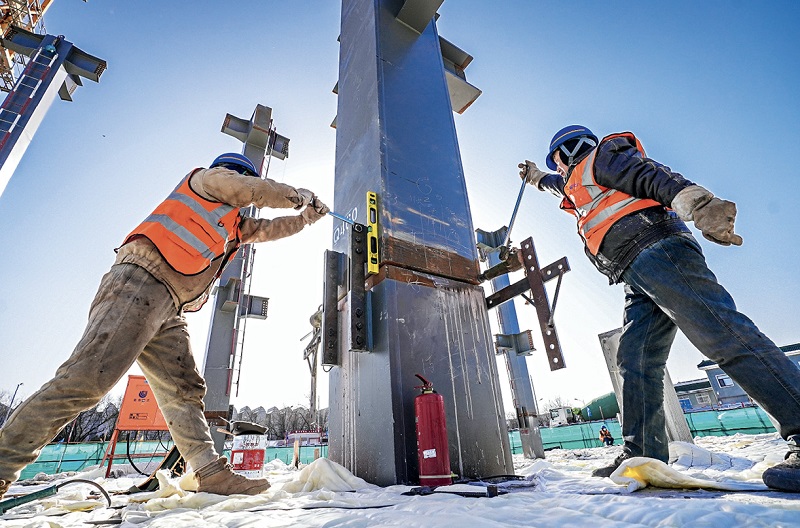A new development pattern grounded in the domestic market, as advocated by President Xi Jinping, is in the making, fueled by China’s dynamic economic comeback and buttressed with supporting national and local policies.
Growing market confidence, buoyed up by the robust rebound of China’s economy, has triggered improved predictions from international institutions for the country’s economic growth. The International Monetary Fund, for instance, sharply lifted its 2023 forecast for China’s economic growth from the previous 4.4 percent to 5.2 percent; and Morgan Stanley raised its outlook for China’s 2023 GDP growth from 5.4 percent to 5.7 percent. The central and local authorities’ rolling out of an array of policies and measures also underpin the market’s rosy future.
Global inflation, regional turmoil, and prevailing uncertainty worldwide, however, remain. At a recent meeting, Chinese President Xi Jinping, also general secretary of the Communist Party of China (CPC) Central Committee, called for efforts to “accelerate the establishment of a new pattern of development,” so as to “better survive, compete, develop, and sustain progress amid all sorts of predictable and unpredictable storms and high winds.” China's domestic market remains the mainstay of the new development pattern, which, first proposed by the CPC leadership in late 2020, features positive interplay between domestic and international economic flows. Xi indicated on January 31, while presiding over the second group study session of the Political Bureau of the 20th CPC Central Committee, that the new development pattern will help to “ensure the country’s development security” and “seize the initiative of future development.”

Workers busy at the construction site of the permanent venue for the Zhongguancun Forum in Beijing on January 28, 2023.
Robust Comeback
Xi emphasized the need to coordinate expansion of domestic demand with deepening supply-side structural reform, thus to create a higher level of dynamic balance.
As the country’s economic recovery enters full throttle, surging domestic consumption propels improvements to the supply side. Inspired by the vigorous market, commodities and services providers at the supply end set about promoting new consumption trends.
Over recent months, tourism, retail, catering, and certain service sectors have spearheaded a dynamic rebound in the country’s domestic economy. Around 308 million domestic trips were made, up 23.1 percent year-on-year, according to the Ministry of Culture and Tourism, during the week-long Spring Festival holiday that ended on January 27. Meanwhile, the combined revenues of major retail and catering businesses saw a 6.8 percent rise over those during last year’s Spring Festival holiday, the Ministry of Commerce announced. China’s cinema box office returns over the celebratory period were the second-highest ever, amounting to around RMB 6.76 billion, official data show. This seasonal boom was evident also in the food delivery market. Online delivery platform Meituan reported a 37 percent increase in businesses offering Spring Festival specialties, sales having surged 71.23 percent over those in 2022. Experts confidently predict that this sizzling domestic consumption bodes well for the rest of 2023.
In January, the Purchasing Manager Index (PMI) of China’s manufacturing industry was 50.1 percent, so re-entering expansion after three consecutive months of contraction. Production is indeed picking up throughout the country. On January 28, the first day of business after the Spring Festival holiday, the construction of 136 key projects broke ground in Xi’an, capital of northwest China’s Shaanxi Province. Covering everything from advanced manufacturing to modern services, they are expected to generate an annual output in excess of RMB 150 billion, as well as to create more than 110,000 jobs, according to a Xinhua report. In the southwestern municipality of Chongqing, meanwhile, 60 or more rotary drilling rigs went into simultaneous operation in January on the new Chang’an Auto factory construction site. “With an investment of RMB 6.3 billion, the project will achieve an annual 280,000 new-energy-vehicle capacity,” project director Wu Kezhi said. Chongqing’s plan to launch 1,123 major projects this year represent an 18.5 percent increase in total investment over last year.
Elsewhere, major economic powerhouses Guangdong, Zhejiang, Shandong, and Sichuan provinces have set their 2023 growth targets at above 5 percent. These new measures, published in local government work reports, are expected to promote high-quality growth of China’s economy and to help shape the new development pattern.
Strong Policy Support
Such heartening momentum owes much to coordinated central and local policy-making. Promoting consumption and expanding domestic demand is China’s top priority in 2023.
China’s central bank continues to inject funds into the financial system through open market operations to maintain the banking system’s reasonable and ample liquidity. On February 9, the People’s Bank of China reported its conduct of RMB 453 billion of seven-day reverse repos – a process whereby the central bank bids for and purchases securities from commercial banks on the understanding it will sell them back at a future date – at an interest rate of 2 percent.
The bank will also guide financial institutions’ increased support for green development, and continue to apply monetary policy tools to ensure carbon emission reductions, clean and efficient use of coal, and efficient logistics.
The Ministry of Commerce recently stated its intention to focus on automobiles and household supplies, and to coordinate national promotional activities aimed at ramping up consumption. The Ministry will also continue the construction of international consumption centers, and maintain its emphasis on developing county-level businesses.
Local governments have rolled out a slew of new measures to spur the economy, ranging from tax breaks to business capital and talent incentives. On February 8, Shenzhen’s Luohu District, a manufacturing and tech hub in southern China, unveiled an array of policies geared to attracting financial institutions, wealth management enterprises, and fund companies. The district will provide a maximum of RMB 50 million in settlement subsidies for new headquarters for such institutions as banks, insurance firms, and securities companies, as well as for related wealth management and asset management subsidiaries. On the same day came the announcement by east China’s Jiangxi Province of 28 policies and measures tailored to unleashing market vitality. The province aims to accelerate the construction of 3,558 major projects this year, reward travel agencies that bring tourists to the province by chartered bus, train, or plane, and also subsidize certain recruitment activities.
Promoting consumption is high on China’s 2023 policy agenda. President Xi further pointed out at the recent meeting, “We must resolutely implement the outline of the strategic plan for expanding domestic demand, form a complete domestic demand system as soon as possible, and strive to expand consumption demand supported by income, investment demand with reasonable returns, and financial demand with principal and debt constraints.”
Upgrade Industrial Chain
President Xi also called on the country to place emphasis, amid its pursuit of economic growth, on development of the real economy; to take solid steps toward advancing new industrialization, and to improve more rapidly China’s strengths in manufacturing, product quality, cyberspace, and digital development.
The spring recruitment drive of the Guangdong One Nano Technology Co., Ltd. in Huizhou’s Zhongkai High-tech Zone is now underway. A 279 percent increase in the company’s revenue in 2022 and a busy order schedule for various nanomaterials to be filled by the second quarter of 2023 prompted the company’s plans to double its staff in 2023.
Nationwide, economic operations are in full swing, upstream and downstream supply chain operations having strengthened, and market expectations uplifted. The new orders index has risen seven percentage points to 50.9 percent, according to a recent release from the service industry survey center of the National Bureau of Statistics and China Federation of Logistics and Purchasing.
The nation’s outstanding performance is also largely attributable to Chinese enterprises’ achievements in digital transformation and business mode innovation. Another example is Foshan-based home appliance manufacturer Galanz. Benefiting from the expansion of intelligent manufacturing production and automatic assembly lines, as well as updates to the information managing system, the company is in receipt of ever more foreign-trade orders for microwave and conventional ovens, toasters, and dishwashers.
In Shanghai’s Pudong New Area, a batch of 146 science and technology industry and supporting projects were signed or started construction on February 1. With a total investment of around RMB 86.7 billion, these projects arise from such sectors as biomedicine, artificial intelligence, integrated circuits, and automobile manufacturing. Among them, construction of the global headquarters park of SmartSens Technology (Shanghai) Co., Ltd., a CMOS image-sensor chip design company, involved a total investment of RMB 850 million.
Chinese enterprises are thus indubitably responding to President Xi’s call to “relieve the stranglehold some countries have tightened on China’s development of core technologies.”

A huge poster of The Wandering Earth II highlighting the blockbuster at a cinema in Beijing, on January 22, 2023, the first day of the lunar new year.
Reforms Spur Vitality
To heighten the driving force and vitality of the domestic circulation and its interaction with the international market, Xi stressed the need to further reform and opening-up.
In early February, China unveiled draft rules to broaden the registration-based initial public offering (IPO) system, marking a big step towards reforming the world’s second-biggest stock market, and better serving the real economy.
The registration-based IPO system was first adopted by the tech-focused STAR Market in 2019. It broadened to start-up board ChiNext in 2020, and the Beijing Stock Exchange in 2021. It will also apply to the main boards in Shanghai and Shenzhen, homes of China’s blue-chip stocks, the China Securities Regulatory Commission said in a statement. The essence of this IPO reform is to “give the right of choice to the market,” and make IPOs “more standardized, transparent, and predictable,” the commission said.
Experts observed that rolling out the registration-based system to all corners of China’s stock market is conducive to establishing a unified market nationwide. The system will help new-economy companies to obtain financing from the capital market, and enhance the capital market’s role in promoting high-quality development and economic structural transformation.
Meanwhile, remarkable progress has been made in reforming China’s state-owned enterprises (SOEs), with major tasks in a three-year action plan involving about 80,000 enterprises, all now completed. SOEs are active players on China’s strategically important industrial fronts. More than 70 percent of central SOEs’ operating revenues are related to national security, the lifeblood of the national economy, and people’s livelihoods. The SOEs raked in RMB 82.6 trillion in operating revenues in 2022, up 8.3 percent over the previous year, official data showed.
The reform has improved SOEs’ corporate governance. About 13,000 subsidiary enterprises of the centrally administered SOEs, and 25,000 subsidiary enterprises of locally administered SOEs, have established boards of directors.
In spurring its domestic growth, the strong recovery in domestic demand and deepened opening up of China’s economy could boost global economic growth by about one percent in 2023, according to a recent report by the Goldman Sachs Group. Meanwhile the country’s market vitality constantly whets the appetites of foreign investors. German carmaker Mercedes-Benz will continue to invest more in China, a senior executive of the company announced recently. “We will expand our layout of R&D and industry chain and accelerate our innovative transformation towards electrification, digitalization, and carbon neutrality to meet the upgrading luxury mobility needs of Chinese customers,” said Hubertus Troska, member of the board of management of Mercedes-Benz Group AG responsible for Greater China. Noting that China is the company’s largest single market and largest production site, Troska added that China is also a technological innovation center and a focus of the company’s industry chain development, playing a crucial role in its long-term global strategy. “We are confident about the long-term development of the Chinese automotive market and our growth potential in the country,” he said.
In 2023, China “can play a very important role in stimulating” global growth, said Hamid Rashid, chief of the Global Economic Monitoring Branch, Economic Analysis and Policy Division, UN Department of Economic and Social Affairs.
In getting off to a good start in 2023, the rapidly rebounding Chinese economy is boosting confidence and nurturing new impetus both domestically and abroad. 
(Based on reports of agencies)